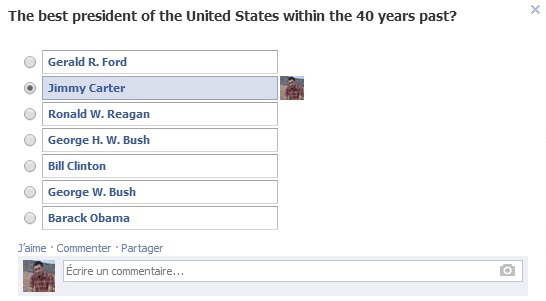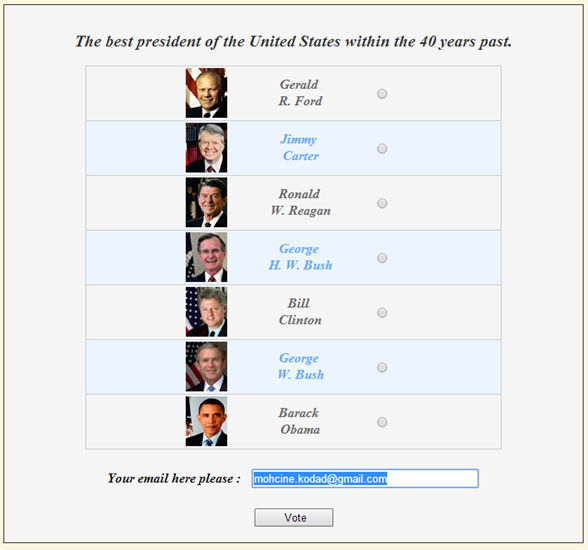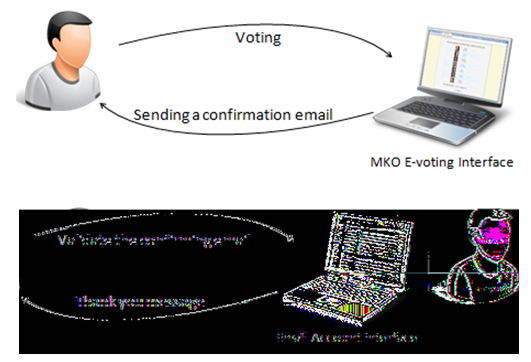-
Paper Information
- Next Paper
- Paper Submission
-
Journal Information
- About This Journal
- Editorial Board
- Current Issue
- Archive
- Author Guidelines
- Contact Us
American Journal of Intelligent Systems
p-ISSN: 2165-8978 e-ISSN: 2165-8994
2014; 4(3): 73-76
doi:10.5923/j.ajis.20140403.01
Online Surveys in Social Networks for Greater Transparency and Credibility
Mohcine Kodad1, El Miloud Jaara1, Mohammed Erramdani2
1Laboratory research in computer science (LARI), Faculty of Sciences (FSO), University Mohammed 1st (UMP), Oujda, 60000, Morocco
2High School of Technology (ESTO), University Mohammed 1st (UMP), Oujda, 60000, Morocco
Correspondence to: Mohcine Kodad, Laboratory research in computer science (LARI), Faculty of Sciences (FSO), University Mohammed 1st (UMP), Oujda, 60000, Morocco.
| Email: |  |
Copyright © 2014 Scientific & Academic Publishing. All Rights Reserved.
This article describes the architecture of MKO E-voting, this is a system that offers more secure online survey system, it is done after the analysis of two types of surveys, the survey offered by facebook and the traditional online surveys offered by some news Web sites. MKO E-voting is a tool that takes into account the principle of facebook that each person by vote, but also it allows to each person having an email account, the right to vote.
Keywords: Secure Poll, IP address, Controlling vote, Online voting
Cite this paper: Mohcine Kodad, El Miloud Jaara, Mohammed Erramdani, Online Surveys in Social Networks for Greater Transparency and Credibility, American Journal of Intelligent Systems, Vol. 4 No. 3, 2014, pp. 73-76. doi: 10.5923/j.ajis.20140403.01.
Article Outline
1. Introduction
- The online survey is an important tool that many organizations use it, to write data and statistics to determine the views and preferences of individuals who compose it, from the study of a sample of participants in the online survey. The online survey has become a very essential way, on the one hand it helps to save time in order to get results in good time, and on the other hand it allows participants to vote in a simple and easy way. Research conducted in this area still needs more security and improvement to ensure the reliability and transparency of voting.In [1] voting system contracts restrict copying, duplication, decompilation, reverse engineering, and preparing derivative works as well as other actions like translation[2], analysis[3], and even extend to training materials and ballots[4]. Contracts consider it a breach of confidentiality if anyone else than the customer’s “employees, agents or contractors” engage in these kinds of activities. And, complicating matters, confidentiality obligations can extend to information recorded in tangible forms (hardware, software, manuals, etc.) as well as oral communications and “know-how” obtained while interacting with the system [5].Thus, transparency which allows direct observation is a key-concept for genuine elections: it allows the detection of structural defects and of some threats to the election process or the voters themselves (frauds, intimidation), that could alter the results. Transparency is a requirement in intergovernmental organizational guidelines for elections [6].We will present in the remainder of this document, The importance of the public survey, The online survey and its reliability with a brief presentation of the problem of online survey, we will also talk about the poll in Facebook groups its advantages and disadvantages, and before concluding we will present MKO E-voting as a solution of the problem of reliability and transparency.
2. The Importance of the Public Survey
- The popular press often decries low voter turnout. Part of the problem can be attributed to the voting process with in the U.S. Voters in the various states must register to vote, often well ahead of the actual voting date. Although polling station locations are published in the local press, voters are often ignorant as to where they are supposed to go to vote. Additionally, concern about whether one's vote counts for much may generate a certain level of apathy. It is also possible that some citizens make a rational decision about voting based on the perceived costs of participation, i.e., the time required to participate in the normal voting process or the need to secure an absentee ballot when one is travelling away from home [7].Secure Electronic Registration and Voting Experiment (SERVE) is one of the most notable online voting systems used in the U.S.A. SERVE was developed by Accenture Limited, Corp. and was funded by the Federal Voting Assistance Program of the U.S. Department of Defence [8]. SERVE's intent was to allow overseas military families to register to vote and vote online. Security was the project's major concern and was the primary reason Accenture's final product was not cleared to be used in the 2008 U.S. Presidential election. Insider attacks, lack of voter-verified audit trails, DOS attacks, spoofing, tampering, fabricated user accounts, and non open-source code were just some of the security concerns identified (Jefferson et al., 2004). Other articles have also pointed out technical and security vulnerabilities in e-voting systems. Security was not found to be a part of the design of two e-voting systems and security features were just added in an ad-hoc manner resulting in numerous vulnerabilities in the systems [9]. Similarly, security gaps in technology were found in online voting pilots in the UK [10]. Other technical and security factors that hinder e-voting systems include lack of transparency [11], potential for accidental or intentional errors in the recording of votes [12], programming errors, potential for tampering, and inability to recover [13].Focus in a study that found those with high trust of e-voting was more likely to be innovators or early adopters of online voting [14]. Despite technical flaws and resistance from some voters, it is very possible that the technologically savvy college age generation of both present and future voting generations will strongly demand the convenience of voting online. A common reason given for e-voting is the potential to increase voter turnout, particularly in the younger age group.
3. The Online Survey and Its Reliability
- Several internet website offers online surveys, such as electronic journals that propose a surveys with some questions for example "What is the personality of the year 2013?", "What's the best player in the world in 2013?," etc. .. With choice proposals and type of vote selected by the committee of the media platform that organizes this survey.Often in online surveys available on the market, it offers four types of voting that are the ways to control the votes, namely:- "None": there is no voting control that is that the user can vote multiple times, and all that will be counted by the counter.- "Cookie": is controlled with cookie when the cookie is saved on the machine the user can not revote.- "IP Address": the vote is controlled with the IP address, time is saved in the database with the user IP address that will not vote a second time.- "IP + Cookie": that say it is the most efficient; once the cookie and IP address are recorded the holder of such information can’t vote a second time.Although the control with "cookie" can destroy only if you remove the "cookie" stored in the browser, the optimal solution here is tied with the registration of the IP address of the machine, but this solution is not also sufficient, because if you delete the cookie and the modem is restarted, the "IP address" is changed suddenly and the user can vote a second time and so it will influence the reliability of the survey.
4. The Poll in Facebook Groups
- Facebook also offers a survey in facebook groups with the “Ask Question” tab, it is dedicating the types of free open question, he offers one and only one issue with one or more Poll Options, and also gives the possibility to add a Poll Options. According to an analysis made on this Facebook poll, we deduced the following points:- Facebook Poll complies with the standard of a free survey and does not allow the person himself to vote multiple times.- Facebook Poll gives the possibility of a person to change his opinion and therefore the possibility to choose another option, what it chooses in the first time, (see Fig.1), for example a Poll “The best president of the United States Within the past 40 years?” At first I voted for the person “Jimmy Carter” and after 3 days I returned to survey and I changed my option and I voted for “Bill Clinton” (see Fig.2) and after several researcher in the field surveys , the survey is reliable only if it does not give the right to amend the initial option selected .- Facebook Poll makes visible all the people who vote, so everyone knows who Mr. X are voted on which candidate, for example in Figure 1, I voted for "Jimmy Carter", so everyone knows the person to whom I voted and this treatment will influence the transparency of the vote.
 | Figure 1. Example facebook poll |
5. MKO E-voting
- About our contribution and as had been shown in figure 2, a person with an email account, it does not necessarily have a facebook account, on the contrary any person registered in facebook must have an email account.
 | Figure 2. UML class diagram between email and facebook accounts |
 | Figure 3. Example for MKO E-voting interface |
 | Figure 4. The steps of votes validation using MKO-Evoting |
6. Conclusions
- The purpose of this paper is to focus on our system proposed to solve some problem of transparency and we discuss the facebook poll, its advantages and its disadvantages. And we discuss also the survey online proposed by some web sites with the main features for validation of votes.In our work, we tried to put a particular security to this type of survey, to limit false votes, as future work we will integrate this code in the facebook code to make it more transparent voting and fight against the uncertainty of the votes and thus prohibit the act of changing our mind.Regarding our perspective, we will integrate a plugin survey on facebook to achieve transparency that was mentioned in the previous paragraph.
 Abstract
Abstract Reference
Reference Full-Text PDF
Full-Text PDF Full-text HTML
Full-text HTML